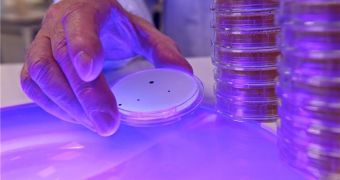A new lighting system that can fight hospital infections like the Methicillin-resistant Staphylococcus aureus (MRSA), and Clostridium difficile – C.diff., was developed by a team of researchers at the University of Strathclyde in Glasgow, in Scotland.
This technology uses a narrow spectrum of visible-light wavelengths called the HINS-light, which sterilizes the air and all exposed surfaces, AlphaGalileo reports.
The HINS-light has a violet chromaticity, but the researchers used a combination of LED technologies that produces a warm white light that can be used alongside regular hospital lighting.
A team of experts including Electrical Engineer – Professor Scott MacGregor, Microbiologists – Professor John Anderson and Dr Michelle Maclean and Optical Physicist – Professor Gerry Woolsey, worked on discovering and developing this new decontamination technology.
“New approaches to disinfection and sterilization are urgently needed within the clinical environment, as traditional methods have significant limitations,” said Professor Scott MacGregor, who is also the Dean of the Faculty of Engineering.
“Decontamination methods involving gas sterilants or UV-light can be hazardous to staff and patients, while cleaning, disinfection and hand washing, although essential routine procedures, have limited effectiveness and problems with compliance.
“HINS-light is a safe treatment that can be easily automated to provide continuous disinfection of wards and other areas of the clinical environment.
“The pervasive nature of light permits the treatment of air and all visible surfaces, regardless of accessibility, either through direct or reflected exposure to HINS-light within the treated environment.”
The team have carried out clinical trials at the Glasgow Royal Infirmary, and the results confirmed that the HINS-light Environmental Decontamination System eliminates more bacterial pathogens than any cleaning or disinfection alone would be able to do.
This breakthrough is a huge step in preventing hospital-acquired infections.
“The technology kills pathogens but is harmless to patients and staff, which means for the first time, hospitals can continuously disinfect wards and isolation rooms,” said Professor Anderson.
“The system works by using a narrow spectrum of visible-light wavelengths to excite molecules contained within bacteria.
“This in turn produces highly reactive chemical species that are lethal to bacteria such as Methicillin-resistant Staphylococcus aureus, or MRSA, and Clostridium difficile, known as C.diff.”
Dr Maclean added that “the clinical trials have shown that the technology can help prevent the environmental transmission of pathogens and thereby increase patient safety.”
This novel technology was developed in Strathclyde's Robertson Trust Laboratory for Electronic Sterilisation Technologies (ROLEST), and the research has been supported by the University of Strathclyde, The Robertson Trust and the Scottish Enterprise Proof of Concept Program.

 14 DAY TRIAL //
14 DAY TRIAL //